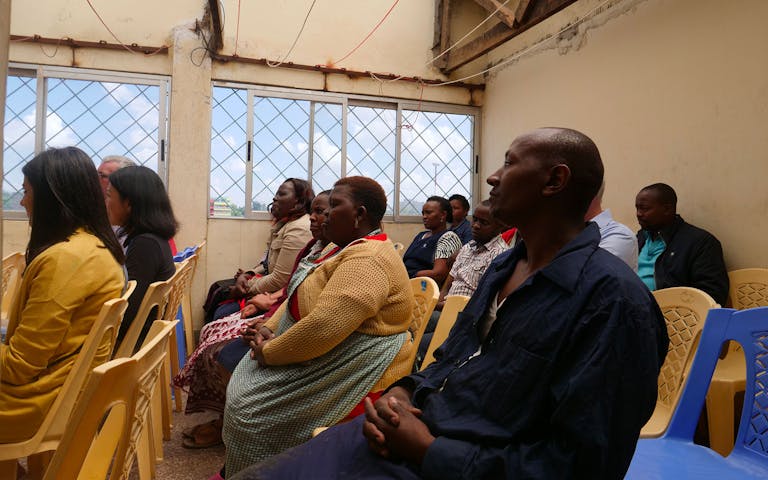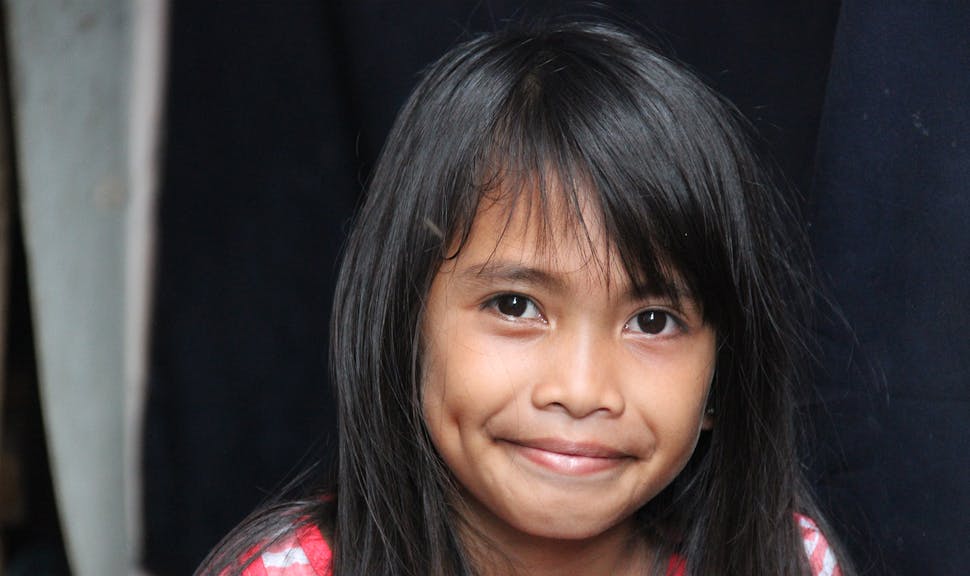

Peter GrossDirector of Strategy, MicroEnsure
March 14, 2018
How Mary, a shoe vendor in Nairobi, saved her business after a fire
When a massive fire devastated Nairobi’s Gikomba market in late 2017, dozens of retailers lost their merchandise, their place of work and their source of income. Mary was one of the victims.
5 minutes
It’s 11:00 AM and the Gikomba market is abuzz. Retailers and artisans have already been hard at work for hours under the blinding sun. Located in western Nairobi, the market is one of the main commercial thoroughfares of the Kenyan capital. Only a handful of tourists stroll through its alleys: the market caters primarily to locals, including consumers and professionals alike. Some have come to buy supplies and materials sold in bulk or fruits and vegetables grown in the neighboring fields. Others take their pick from among countless mitumba stands. This Swahili term refers to the bundles of used clothes sold in colorful plastic bags.

Let’s meet Mary
Mary greets customers under the shade of her stand, where she has laid out an array of used shoes. She opens at 8:00 AM, as she has done every day for 17 years. Like many vendors in this part of the market, she earns about 500 Kenyan shillings (about 5 dollars) a day on average. On a good day, I might get 1,000 shillings, but there are some days where I don’t sell a thing
, she explains.


As the mother of a small child, Mary has ambitions: move into a bigger house, expand her business, and – why not? – open another shop. But in Autumn 2017, all her dreams nearly came crashing down.
On the night of Friday, October 6, a fire broke out in the market at 3:00 AM, engulfing a large portion of the textile corridor in just a few hours and destroying tens of thousands of dollars of merchandise.
The fire impacted all my fellow retailers on the market
, tells Mary. Stalls burned to ashes and valuable goods went up in smoke: a total of 300 people found themselves, like Mary, unable to work.
For Mary and her family, the situation could have gotten much worse, since Mary financed her business with a microloan of 35,000 shillings (340 dollars) issued by the microfinance institute Musoni. Fortunately, the loan contract included a micro-insurance clause: the Musoni Group Enhanced Credit Life policy. Designed and distributed by MicroEnsure*, the policy notably covers policyholders in case of death, hospitalization and also fire. This meant that the policy covered Mary’s loan balance in full. On top of that, she also received 1,000 shillings within a few days of the event to help her family cope with a short-term loss of income.
*MicroEnsure, in which AXA is the largest shareholder, is a specialist in developing inclusive insurance offers for low-income and middle-income groups in Africa and Asia.
About sixty people at the market benefited from this type of insurance. We covered their losses up to a total of 3.2 million shillings, or 32,000 dollars
, recalls Kiereini Kirika, regional director for East Africa at MicroEnsure.

Kenya: millions of people to protect
Mary is far from an isolated case in Kenya. Millions of Kenyans, including artisans, farmers and retailers, face risks that threaten the security of their families and the fabric of their communities.

Kenya is home to a large population of emerging customers. Forming the middle of the social pyramid, this population segment sits between the poverty line and the middle class, earning too much to benefit from aid programs, but not enough to withstand a major disaster. Since their revenue can fluctuate widely from month to month, they often lack the funds needed to access classic insurance products to protect against risks, notably the elevated risk of economic stress that they face.
Most of our customers are women
, explains Ronnie Gichuki, from MicroEnsure Innovation Lab, MicroEnsure’s internal innovation hub, which tests out new offers and distribution channels. Many of them have families to feed and earn between 200 and 300 Kenyan shillings a day. They often run a small retail activity.
Health insurance for all is one of the commitments outlined by Uhuru Kenyatta, Kenya’s President who won a second term in November 2017. Emerging customers now have urgent needs to meet in the country. Kenya has notably shown promise when it comes to insuring emerging customers: 5.98% of the population is covered by organizations like MicroEnsure. While this figure leaves a lot of room for improvement, it remains one of the highest penetration rates in East Africa. And these insurance policies are growing increasingly popular among across the country.
One of the reasons behind this success is that insurance policies are tailored to meet specific needs: in fact, they are designed by analyzing data collected on the ground. Their development takes place over a long process of identifying the needs of emerging customers and finding the most effective way to meet these needs, while keeping their habits and behaviors in mind. This innovation process based on observing users’ actual practices has a name: design thinking. Conceived at the Stanford d.school, design thinking aims to pinpoint the needs of end customers in order to optimize their experience and ability to adopt the product.
Insurance products are frequently designed by teams of office workers armed with spreadsheets
, explains Peter Gross, Strategy Director at MicroEnsure. That’s not how we do business. Design thinking is not a side project for us. We place it at the center of our approach.
Focus groups representative of target customers are a crucial part of identifying customer demands. These take place during the earliest stages in designing each new offer, so that teams can build policies to meet actual needs, rather than projections.

This dynamic growth is not only due to the capacity of these insurance solutions to meet the needs of emerging customers. It is also made possible by the presence of innovative companies that have helped roll out these new solutions in the country.
Like most of her fellow vendors at the market, Mary always has her mobile phone on her, which enables her to send and receive money at any time. It was M-Pesa, the giant in mobile-to-mobile money transfers, which paved the way for innovative financial services designed for individuals. Launched in Kenya in 2007, the solution spread across every corner of Africa in just ten years. Using mobile phones to send and receive money is a perfect way to compensate emerging customers after an accident.
Working closely with Emerging Customers
But the strong growth of insurance solutions in Kenya is also due to a fundamental effort to reach potential customers. This process relies on building relationships between MicroEnsure and local partners: Musoni in the area of microfinance, Airtel in mobile telephony, etc. Firmly rooted in the local economic fabric for many years, these partners know the ins and outs of all the challenges faced by local populations and help to provide more points of contact with future policyholders. In this way, many customers can benefit from insurance solutions packaged together with their microloan, just like Mary, or with their mobile phone plan.

A strong and friendly relationship with customers is the second biggest factor in expanding protection for emerging customers.
Gladys Wangari is a member of the MicroEnsure teams who make the rounds of Nairobi’s markets every day to meet with potential customers. The information she provides is crucial to helping emerging customers learn how insurance can protect them against risks. I meet 50 customers a day
, she explains. I have to explain to them what insurance is. Many of them don’t know what it does or why it’s important to be insured.
Back in Nairobi, Mary’s workday is coming to an end. As she makes her way through the market’s alleys to board the matatu (private shuttles that provide the city’s bus service) that will take her back to her neighborhood, Mary waves to her fellow vendors, who answer back with a smile. In this country where informal insurance solutions remain widely popular, it is their support – together with the kindness of friends and family – that Mary would have had to rely on if she didn’t have insurance.



